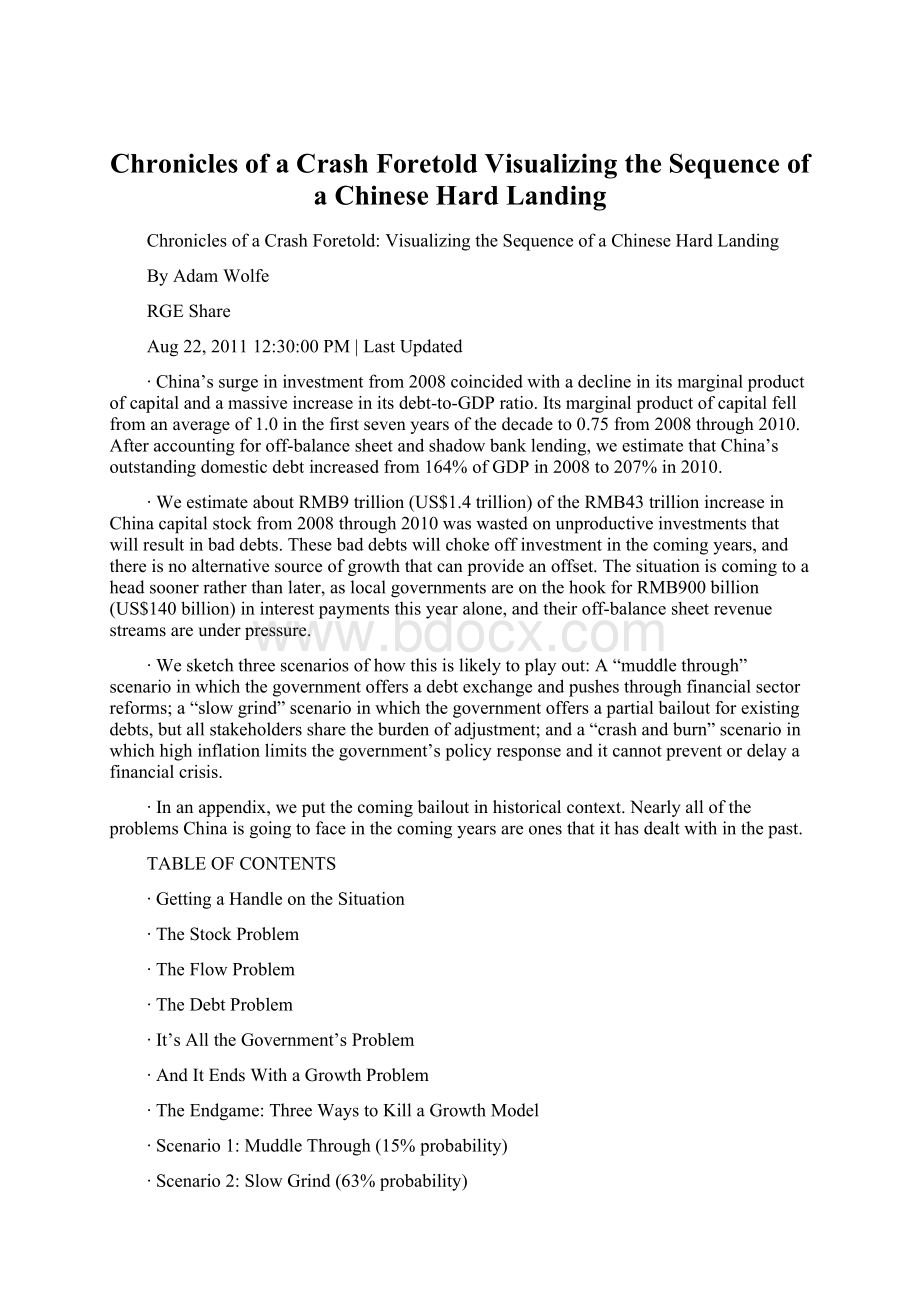Chronicles of a Crash Foretold Visualizing the Sequence of a Chinese Hard LandingWord格式.docx
《Chronicles of a Crash Foretold Visualizing the Sequence of a Chinese Hard LandingWord格式.docx》由会员分享,可在线阅读,更多相关《Chronicles of a Crash Foretold Visualizing the Sequence of a Chinese Hard LandingWord格式.docx(17页珍藏版)》请在冰豆网上搜索。

30:
00PM|LastUpdated
∙China’ssurgeininvestmentfrom2008coincidedwithadeclineinitsmarginalproductofcapitalandamassiveincreaseinitsdebt-to-GDPratio.Itsmarginalproductofcapitalfellfromanaverageof1.0inthefirstsevenyearsofthedecadeto0.75from2008through2010.Afteraccountingforoff-balancesheetandshadowbanklending,weestimatethatChina’soutstandingdomesticdebtincreasedfrom164%ofGDPin2008to207%in2010.
∙WeestimateaboutRMB9trillion(US$1.4trillion)oftheRMB43trillionincreaseinChinacapitalstockfrom2008through2010waswastedonunproductiveinvestmentsthatwillresultinbaddebts.Thesebaddebtswillchokeoffinvestmentinthecomingyears,andthereisnoalternativesourceofgrowththatcanprovideanoffset.Thesituationiscomingtoaheadsoonerratherthanlater,aslocalgovernmentsareonthehookforRMB900billion(US$140billion)ininterestpaymentsthisyearalone,andtheiroff-balancesheetrevenuestreamsareunderpressure.
∙Wesketchthreescenariosofhowthisislikelytoplayout:
A“muddlethrough”scenarioinwhichthegovernmentoffersadebtexchangeandpushesthroughfinancialsectorreforms;
a“slowgrind”scenarioinwhichthegovernmentoffersapartialbailoutforexistingdebts,butallstakeholderssharetheburdenofadjustment;
anda“crashandburn”scenarioinwhichhighinflationlimitsthegovernment’spolicyresponseanditcannotpreventordelayafinancialcrisis.
∙Inanappendix,weputthecomingbailoutinhistoricalcontext.NearlyalloftheproblemsChinaisgoingtofaceinthecomingyearsareonesthatithasdealtwithinthepast.
TABLEOFCONTENTS
∙GettingaHandleontheSituation
∙TheStockProblem
∙TheFlowProblem
∙TheDebtProblem
∙It’sAlltheGovernment’sProblem
∙AndItEndsWithaGrowthProblem
∙TheEndgame:
ThreeWaystoKillaGrowthModel
∙Scenario1:
MuddleThrough(15%probability)
∙Scenario2:
SlowGrind(63%probability)
∙Scenario3:
CrashandBurn(22%probability)
∙Appendix:
TheGhostofChinaBrokeninthePast
∙RestructuringtheState-OwnedBanks
∙China’sShadowBankingSystem
∙TheHainanPropertyBubble
∙HistoryRepeatsItself
China’sgrowthmodelhasalreadycrossedtheeventhorizon;
theonlyquestionishowitwillbecrushed.Overthepastdecade,60%ofChina’sgrowthhascomefrominvestmentandnetexports,asarapidlyexpandingphysicalcapitalstockhashelpedtoimproveitsexportcompetitiveness.Thiswasnevergoingtobesustainableinthelongrun—shiftingdemographicswouldhavestartedtoreversetherepressionofhouseholdincomes,whichwouldhavebiduptheartificiallycheapcostofcapitalmakinginvestmentmoreexpensiveandensuringthattheRMBwoulddriftupwardtowardfairvalue—butitwasthemaniaofthe2008-11investmentboomthatpushedtheChinesegrowthmodelintotheabyss.
AsNourielRoubinirecentlyargued,thisinvestmentboomisleadingtomassiveovercapacitiesthatwillgeneratecolossalnonperformingloans(NPLs),riskingahardlandingsometimeafter2013.Here,wequantifytheproblem,sumupthelikelycostsandprovidethreedistinctscenariosfortheendgame.
GETTINGAHANDLEONTHESITUATION
TheStockProblem
Chinaisnowthesecond-largesteconomyintheworldand,basedonourcalculations,itisthethird-richestcountryintermsofphysicalcapital,ortheaccumulatedvalueoffixedassets.WebaseourestimatesonanupdateofNehruandDhareshwar(1993),whichcalculatedthestocksof92emerginganddevelopedmarketsfrom1950through1990.Usingtheirestimatesofeachcountry’sinitialcapitalstockintheearly1950s,weemploytheperpetualinventorymethodtoestimatecapitalstocksin2010.Inthiscalculation,theflowofnewinvestmenteachyearisaddedtotheexistingcapitalstock,whichdepreciatesovertime.Weholdtheirassumptionthatexistingcapitalstocksdepreciateatauniform4%rateeachyearacrosseverycountry,eventhoughthisiscertainlyasmallerrorthatcompoundsovertime.
WhileChinaranksnearthetopofourleaguetablefortotalcapitalstock,itcomesclosetobottomonaper-capitabasis.Thissuggeststhatithasyearsofcapitalaccumulationaheadofit,andthatChina’sinfrastructureisnotover-builtintheaggregate.Inthelongrun,thisiscertainlytrue.However,inthenearterm,theinfrastructurethatChinahasbuiltisnotaddingtooutputfastenoughtopayforitself,and,withaninvestmentrateofnearly50%ofGDP,thisisnosmallproblem.
Figure1:
ChinaIsaRichCountry,FullofPoorPeople
Source:
NehruandDhareshwar(1993),IMF,WorldBank,NationalStatistics,RGE
TheFlowProblem
WhiletherearesomeproblemswithChina’sstockoffixedassets,therealproblemhastodowithitsflowofinvestment.AnycountrythatbuildsanewhighwayisgoingtoseeajumpinGDP(grosscapitalformation)andanincreaseinproductivity(moreefficientmovementofgoodsandlabor).Simultaneously,buildingarailwayofequalvalueparalleltothathighwaywoulddoubletheboosttoGDP,buttheproductivitygainfromeachprojectwouldnecessarilybeless,whichwouldweighongrowthinthelongerrun.ThisisthesituationinwhichChinafindsitselftoday—arisingflowofinvestment,withalowerreturnonitscapital.
Figure2:
TheFlowInvestmentOverwhelmsConsumption(%ofGDP)
NationalBureauofStatistics
WhendemandforChina’sexportscollapsedin2008,policymakersinBeijingneededanalternativesourceofgrowthandsotheyopenedthefloodgatesforlocalleaderstobuildnearlyanythingtheywanted,solongasitcreatedjobsandGDP.Thisledtoamassiveinvestmentinhigh-speedrailways,highways,airports,luxuryapartments,windpowerandheavyindustrialcapacity.WhileintheaggregateChinastillhasadeficitofinfrastructure,thespeedinwhichthesenewprojectsarecomingonlinenegatestheusefulnessofeachofthem.Therewasnotimeforarealassessmentofwhichnewhighwayswereneeded,letalonehowthoseroadswouldbeaffectedbythenewhigh-speedraillineplannedalongthesameroute.Instead,anythingthatwasonalocalleader’swishlistwasgiveninstantapproval.ThereasoneveryleaderhadsuchalongwishlistwasbecausetheNationalDevelopmentandReformCommissionhadpreviouslyjudgedmostproposalsaslackinginanyeconomicjustification.However,eveniftheseplanshadbeensound,productionsimplycannotbeshiftedaroundfastenoughtokeepupwiththepaceofChina’scurrentinvestmentrate.Theendproductofpoorplanningandrapidinvestmentisclear:
TherearemassivetrafficjamsgoingintoBeijingwhilethecityisringedwithemptyluxuryapartmentsandvillas.Wind-poweredgeneratorssitunconnectedtothestategrid,whilenewcoal-firedplantsarebuiltdowntheroad.High-speedrailwaysrunnearlyempty,whilecoalshipmentsoverwhelmtheexistingfreightnetwork.TheresulthasbeenacollapseinthemarginalproductofChina’scapital,ortheamountofGDPeachdollarofinvestmentgenerates,aproblemthatwillcompoundaslongaspolicymakerscannotfindalternativesourcesofdemand.
Figure3:
InvestingforGDP,NotProfit(RMB,trillions)
NehruandDhareshwar(1993),IMF,WorldBank,NationalBureauofStatistics,RGE
Adeclineintheproductivityofcapitalisawarningsignofproblemstocome,asitimpliesinvestmentgrowthisnotsustainableatitscurrentrate.China’smarginalproductofcapitalfellfromanaverageof1.0inthefirstsevenyearsofthedecadeto0.75from2008through2010.Givenourgrowthforecastsfor2011-12,weexpectChina’smarginalproductofcapitaltoremaincloseto0.7thisyearandnext.SouthKoreaandMalaysiasawsimilardeclinesintheircapitalproductivityinthefiveyearspriortothe1997Asianfinancialcrisis.Brazil’sratiofellsharplyin1996,twoyearsbeforeitscurrencycrisis.ThemarginalproductivityofcapitalinSpaindeclinedsharplyin2002andstayedlowuntilthebottomfelloutin2008.IntheU.S.,theratiodeclinedsteadilyfrom2004throughthecrashin2008.AlthoughChinadoesnotrunacurrentaccountdeficitorhaveanovervaluedcurrency,ittoowillrunintoawallaslongasitcontinuestopourfundsintounproductiveinvestments.
TheDebtProblem
TheweaknessinChina’sgrowthmodel,aswithallofthoseabove,isthatthevastmajorityoftheseunproductiveinvestmentswerefinancedwithdebt.WeestimatethatChina’sdomesticdebt-to-GDPratioincreasedfrom164%in2008to207%in2010,astotaldebtoutstandingincreasedby60%toRMB82trillion(US$12.4trillion).Asharpincreaseindebt-to-GDPisanotherwarningsignofcomingproblems.InHymanMinsky’sfinancialinstabilitytheory,anincreaseindebtwithoutasimilarriseinoutputindicatesthatdebtisdriftingfrom“hedge”borrowing,inwhichcashflowcancoverdebtobligations,to“speculative”borrowing,inwhichcashflowcanonlycoverinterestpaymentsor“Ponzi”financing,whichrequireseverrisingassetpricestocovereveninterestpayments.Thatmuchoftheincreasein2010camefromoff-balancesheetlending,similartothespecialpurposevehicleswesawduringtheU.S.subprimebubble,compoundstherisk.Itseemsthatloansthatcouldnotberepaidhavebeenrolledoverintodebtsthatregulatorscannoteasilyfind.Ifbanksfindthemselvesunabletokeeprollingovertheseobligations,NPLswouldquicklyeatthroughthestate-ownedbankingsector’sprovisions.
Figure4:
China’sGrowingDebtBurden